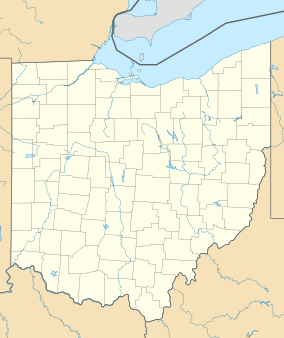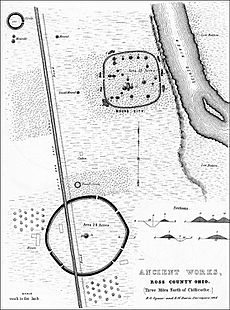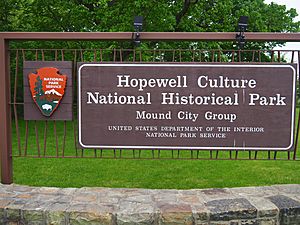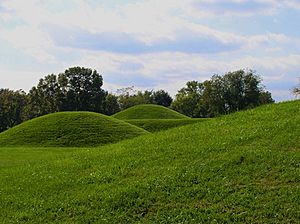Hopewell Culture National Historical Park facts for kids
Quick facts for kids Hopewell Culture National Historical Park |
|
|---|---|

Restored mounds in the Hopewell Culture NHP
|
|
| Location | Ross County, Ohio, United States |
| Nearest city | Chillicothe, Ohio |
| Area | 1,170 acres (4.7 km2) |
| Established | March 2, 1923 |
| Visitors | 33,834 (in 2011) |
| Governing body | National Park Service |
| Website | Hopewell Culture National Historical Park |
| UNESCO World Heritage Site | |
| Part of | Hopewell Ceremonial Earthworks |
| Criteria | Cultural: i, iii |
| Inscription | 2023 (47th Session) |
| Area | 320.7 ha |
| Buffer zone | 561.8 ha |
Hopewell Culture National Historical Park is a special place in Ohio, USA. It protects amazing ancient earthworks and burial mounds. These were built by the Hopewell culture, a group of Native American people. They lived here a very long time ago, from about 200 BC to 500 AD.
This park is made up of four different sites you can visit in Ross County, Ohio. One of the most famous parts is the former Mound City Group National Monument. The park helps us learn about the Hopewell people through archaeology, which is the study of human history through digging up old things. The National Park Service takes care of the park. In 2023, it became part of the Hopewell Ceremonial Earthworks World Heritage Site, which means it's important to the whole world!
Contents
Where is Hopewell Culture National Historical Park?
Hopewell Culture National Historical Park has four different areas that are open to everyone. They are all located in Ohio:
- Mound City Group is where you'll find the visitor center. It's the only Hopewell site that has been fully restored to look like it did long ago. You can find it at 16062 State Route 104, Chillicothe, OH 45601.
- Seip Earthworks is another site, located at 7078 US Route 50, Bainbridge, OH 45612.
- Hopewell Mound Group is at 4731 Sulphur Lick Rd., Chillicothe, OH 45601.
- Hopeton Earthworks is located at 990 Hopeton Rd., Chillicothe, OH 45601.
The Story of the Hopewell People
Who Were the Hopewell People?
From about 200 BC to 500 AD, the Ohio River Valley was a very important area for the ancient Hopewell culture. The name "Hopewell" comes from the person who owned the land where one of these amazing sites was found. It describes a wide network of shared ideas and practices among different Native American groups. These groups lived across a large part of eastern North America.
The Hopewell people were known for building large enclosures with earthen walls. These walls often formed cool geometric shapes like squares and circles. They also built mounds of different shapes and sizes. Today, you can see many signs of the Hopewell culture in the Scioto River valley, near the city of Chillicothe, Ohio.
The most impressive Hopewell sites have huge earthworks. These are like giant drawings on the ground made from earth. They include squares, circles, and other geometric designs. Many of these sites were built on a massive scale. Their earthen walls could be up to 12 feet (3.7 m) high. Some of the geometric shapes stretched more than 1,000 feet (300 m) across!
You can also find conical (cone-shaped) and loaf-shaped earthen mounds. These mounds could be up to 30 feet (10 m) high. They were often built near the geometric earthworks. The people who built them knew a lot about the local soils. They mixed different types of earth to make their structures super strong and stable. Building these required thousands of hours of hard work. People carried the earth in baskets woven by hand.
Mound City is a famous site located about 4 miles (6 km) north of Chillicothe. It's right along the Scioto River. This site has 23 earthen mounds built by the Hopewell culture. Each mound was built over the remains of a charnel house. A charnel house was a special building where they prepared the dead. After the Hopewell people cremated (burned) their dead, they would burn the charnel house too. Then, they built a mound over the ashes and remains. They also placed valuable items in the mounds. These items included copper figures, shiny mica, sharp projectile points, shells, and pipes.
Finding and Protecting These Ancient Sites
People from Europe first mapped these sites in the 1840s. Two early archaeologists, Ephraim George Squier and Edwin Hamilton Davis, were the first to dig here. They collected many artifacts from the mounds. These items are now kept safe at the British Museum. Sadly, much of Mound City was destroyed during World War I. The United States Army built a military training base called Camp Sherman right on top of the site.
After the war, the army tore down the camp. From 1920 to 1922, the Ohio Historical Society did an archaeological excavation (careful digging) of the site. After their work, they rebuilt the mounds. In 1923, the Department of Interior declared Mound City Group a U.S. National Monument. This meant the government would protect and manage it.
In 1992, Mound City Group got a new name and became bigger. It was renamed Hopewell Culture National Historical Park. This new park included parts of four other nearby earthwork and mound systems. Two of these sites in Ross County are close to Mound City and are open to visitors. Seip Earthworks is about 17 miles (27 km) west of Chillicothe on U.S. Route 50. Hopewell Mound Group is where an important dig happened in 1891. This land belonged to Mordecai Hopewell, which is how the culture got its name! Hopeton Earthworks is located across the Scioto River from Mound City.
The Ohio Historical Society also looks after other mound systems and amazing earthworks in southern Ohio. These include National Historic Landmarks like Fort Ancient, Newark Earthworks, and Serpent Mound. Sadly, fifteen other mound complexes that were once in the county have been lost. They were destroyed by farming or city growth.
The national park protects very important archaeological sites. These include large earthwork and mound complexes. They help us understand the smart and complex ways the Hopewell people lived. We learn about their social life, ceremonies, politics, and how they traded goods.
The park's visitor center has a film to introduce you to the park. You can also buy books there. Plus, you can take self-guided tours to explore the sites on your own.
See Also
- Hopewell Ceremonial Earthworks World Heritage Site
- List of Hopewell sites






